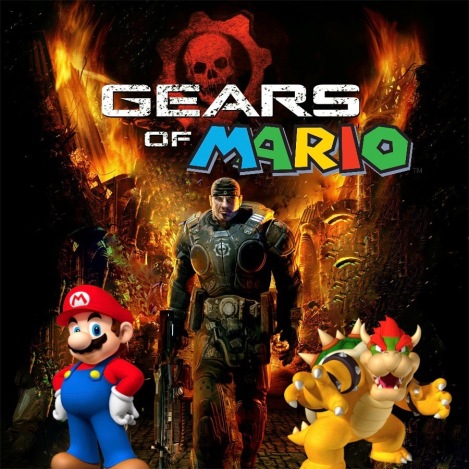DS106 Mashup: Gears of Mario

“Take two existing video game covers and mash them up so that both can be identified but in a different style. Try to be creative in the title and artistic design.”
The Process
Wouldn’t this be an awesome game to play?! I know that this week’s DS106 assignment was supposed to explore our chosen theme, and video games are hardly related to photography, but I did have to manipulate photos! So in my opinion, it counts! First, I downloaded a picture of the Gear of War cover, featuring Marcus Fenix in the foreground, with Ben Carmine and Dom Santiago in the background. Using the retouch tool in the Photos app on my Macbook, I photoshopped them out, along with the “War” in the title. Then, I looked up some pictures of the Super Mario logo, along with Mario and Bowser, and overlaid them onto the new cover using PicMonkey! It didn’t take too long at all, and I was able to accomplish it without anything too fancy.
The Story
Super Mario 64 was my favorite video game as a child, and still totally my favorite now that I bought another Nintendo 64 after my parents so graciously “donated” my old one because I’d gotten “too old” or something. Anyway, Gears of War was also my favorite video game series as I got older and into high school and college, and both my Nintendo 64 and old-school XBOX 360 are sitting in my basement, ready to be played as soon as I’m done blogging about this. I haven’t been able to touch them for almost a year because I’ve either been out of town or too busy. Or too cold. Mostly that. Basements are chilly!
Anyway, I like video games, especially the simpler ones like Super Mario and Gears of War because they keep me thinking on my feet and help me adapt to lots of situations. I’ve always found that if I play video games regularly for a while, I get a little bit more street smart. Sometimes I’m prone to overthinking because I have too much of the book smart and not enough of the street smart, and then I just shut down because I never know what to do and it’s super not cool. Video games get a lot of flak from society because they’re supposedly bad for you, but recent studies have shown that they can actually be really beneficial for your cognitive development. Basically, they can help you improve your spatial perception, visual skills, hand-eye coordination, reaction time, ability to overcome challenges, and overall brain growth. Hear that, fellow gamers? Video games are good for you! No need to tell me twice. See you all later! I’ll be busy swinging Bowser by his tail and taking out Locusts with my chainsaw bayonet.
© Emily Joan Wu
Teacher Candidate | Math
University of Colorado Denver
INTE 5340 | Summer 2016



